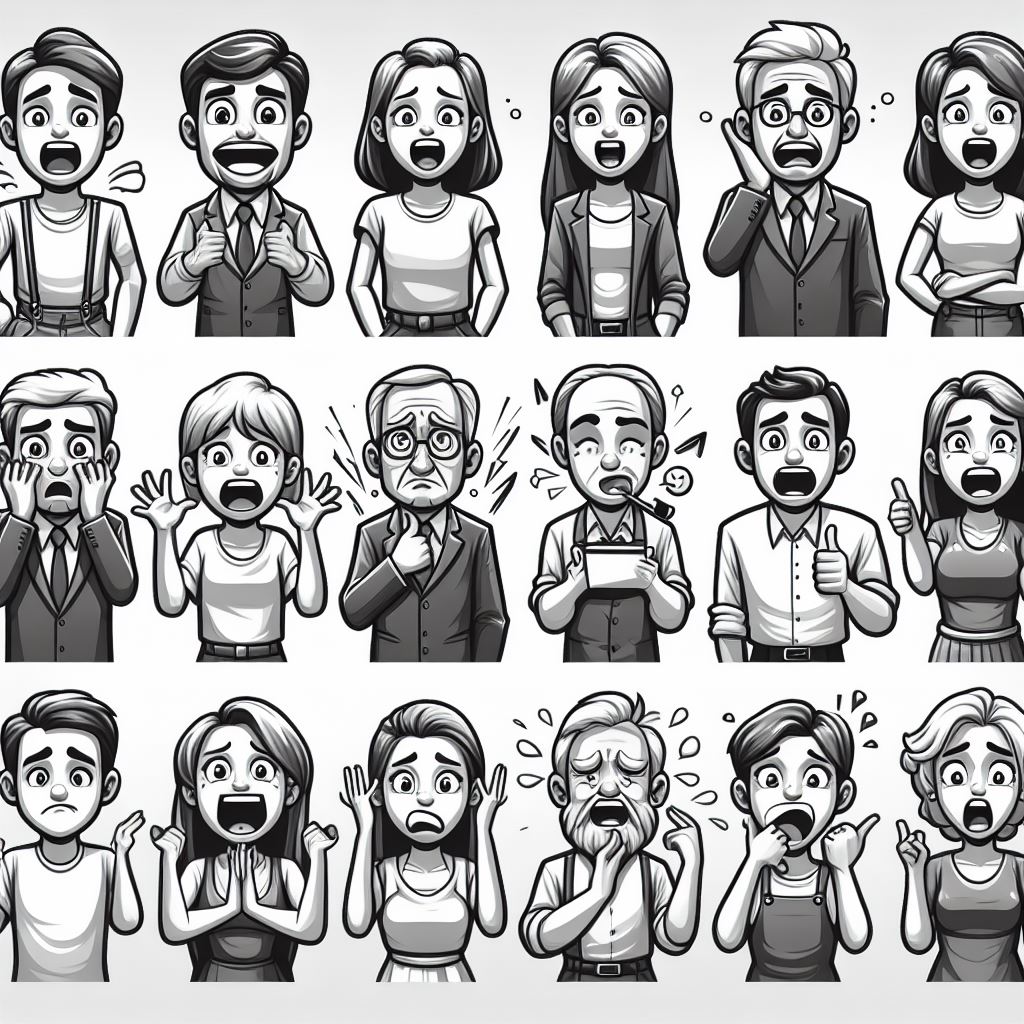Emotional dysregulation, while commonly linked to experiencing intense emotions, goes beyond the mere intensity of feelings. It involves the skill of selecting the most suitable emotional response for a particular context, understanding these emotions, and having the capacity to reflect on and modulate them.
What are the 5 types of dysregulation?
It is theorised that emotional dysregulation is influenced by five areas of emotional functioning, namely
- decreased emotional awareness
- inadequate emotional reactivity
- intense experience and expression of emotions
- emotional rigidity
- cognitive reappraisal difficulty
Let’s discuss each of these components in detail, and then answer some common questions about emotional dysregulation.
Table of Contents

Decreased emotional awareness
Emotional dysregulation often involves decreased emotional awareness, which means having difficulty recognising and labelling your own feelings. This can range from having a blurry picture of how you feel inside all the way to having no idea how you feel.
Not understanding our emotions is different from expressing emotions outwardly. The good news is that emotional awareness grows as we age and learn more about our feelings. Being aware of your emotions is the first them for managing them effectively, so therapy usually starts with being able to recognise and label our emotions accurately.
Inadequate emotional reactivity
Another aspect of emotional dysregulation is inadequate emotional reactivity, which means reacting inappropriately to strong emotions. It’s like having a response that doesn’t match the situation, such as laughing during a sad moment. Emotional reactivity is the initial, uncontrolled response to something that triggers an emotion.
Interestingly, trying too hard to control emotions can also lead to intense reactions. Suppressing negative emotions for too long can make them stronger and more difficult to manage, and they eventually burst out in unhelpful ways. Learning with the help of a psychologist to express emotions constructively is a key part of therapy.
Intense experience and expression of emotions
Experiencing and expressing emotions intensely can be a sign of emotional dysregulation. This can involve feeling very strong negative emotions, like sadness or anger, which can lead to problems in how we adjust to our environments, friends, relationships, and even our mental health. Emotion regulation is often seen as managing these negative feelings, but it also includes dealing with intense positive emotions.
We might think positive emotions are always good, but extreme, uncontrolled positive emotions also can lead to problems, such as doing things we regret later. People sometimes engage in high-risk activities when they feel “too good”, and that can have long-lasting consequences in terms of their health, relationships, and reputation.
Emotional Rigidity
Emotional rigidity is a key part of emotional dysregulation, where flexibility is needed to adapt to life’s daily challenges. Emotional rigidity can show up in two ways: a restricted emotional range and context-inappropriate emotional responses.
Restricted emotional range means having difficulty experiencing and expressing a variety of emotions. Instead, there might be an overwhelming focus on one emotion (for instance, jealousy or sadness), making it hard to switch to others.
Context-inappropriate emotional response means that our emotional responses don’t match the situation. This can happen in a few ways, such as expressing emotions that go against norms, which can be seen as rude or offensive, such as feeling excitement when observing something sad. Moreover, we might show emotions that are so unexpected or unusual for the situation that others might think it is deviant. Lastly, we might not show any emotions, even though it’s expected, for instance, when observing something terrifying and we fail to react emotionally.
Cognitive reappraisal difficulty
The final aspect of emotional dysregulation is the difficulty with cognitive reappraisal (cognitive dysregulation), a technical term for our ability to think about and re-evaluate our emotions and give them new meanings when necessary. For instance, we might initially feel very sad after a loss, but thinking about it later we might see it more grayscale, and the opportunities we might gain. This process is crucial for finding appropriate emotional responses and adapting to different situations.
Cognitive reappraisal can change how we experience emotions, how we behave, and even our physical reactions. It’s not about suppressing emotions but about changing how we interpret them. Using cognitive reappraisal as a regular strategy for managing emotions is linked to better mental health and lower levels of emotional problems. On the other hand, having difficulty with cognitive reappraisal is associated with more mental health issues. This difficulty is found in several psychiatric disorders, including autism spectrum disorder, PTSD, and borderline personality disorder.
What causes emotional dysregulation?
The most common causes of having difficulties with understanding, expressing, or feeling our emotions are due to childhood trauma, which can mean a big traumatic event, or ongoing smaller traumatic events, such as verbal or physical aggression at home when we are growing up. What initially was adaptive for us as a kid to manage our emotions as a reaction to these traumatic events, is usually not helpful as adults.
In line with this, invalidating environments in childhood, such as parents dismissing our feelings (“you shouldn’t cry just because of […]”) often leads us to not understanding our emotions, or not knowing how to express them, a key part of emotion regulation.
There is also research showing that low serotonin levels might contribute to emotional dysregulation, but it is not yet clear if causing it, or just a symptom of other challenges, such as childhood trauma.
How do you deal with emotional dysregulation?
The first and most important step is to learn to recognise and label our emotions accurately. This in itself gives us the feeling of being more in control of our emotions, another key part of emotion regulation.
Some therapeutic approaches, such as DBT, are designed to help us manage our emotions better, both our big and unhelpful emotions, and to learn to express other emotions more accurately and constructively.
Can you have emotional dysregulation but not BPD?
Yes, as we mentioned earlier, emotional dysregulation is not the same as BPD (borderline personality disorder). Many other disorders affect the way we feel, such as PTSD (both extreme responses to some situations, and limited responses to others), bipolar disorder (inability to control positive emotions), or ADHD (difficulties with containing emotions).
While diagnostic labels are important, specialised therapy, such as DBT, can help to learn to manage our emotions, regardless of the exact diagnosis.
examples of emotional dysregulation
Emotional dysregulation symptoms include anger, mood swings, intentional self-harm, and dissociation.
Intense Anger
Individuals experiencing emotional dysregulation may exhibit disproportionate anger responses to minor provocations. This heightened reactivity is often linked to conditions such as Attention Deficit Hyperactivity Disorder (ADHD) and Borderline Personality Disorder (BPD). Research indicates that during anger episodes, the amygdala, the brain’s fear and anger center, becomes more reactive, while the prefrontal cortex, responsible for rational thinking and self-regulation, shows reduced activity. This neural imbalance impairs the ability to manage anger effectively, leading to intense emotional outbursts that are very hard to control. However, either with CBT therapy or DBT therapy, people can learn to predict and manage their emotions better.
Mood Swings
Emotional dysregulation often involves rapid and intense mood fluctuations, commonly observed in mood disorders such as Bipolar Disorder and BPD. Individuals may experience swift transitions from euphoria to deep sadness or irritability without clear external triggers. These mood swings can disrupt daily functioning and strain interpersonal relationships, necessitating comprehensive therapeutic approaches to enhance emotional stability.
Self-Harm
Self-harming behaviors, including non-suicidal self-injury (NSSI), are prevalent among individuals struggling with emotional dysregulation. Such behaviors often serve as maladaptive (not helpful) coping mechanisms to manage overwhelming emotions. Studies have found that greater emotion dysregulation is associated with a higher risk for NSSI across various populations, regardless of age or sex. Limited access to emotion regulation strategies, may have unique implications for non-suicidal self-injury risk.
Dissociation
Dissociation involves a disconnection between thoughts, identity, consciousness, and memory, often serving as a psychological escape from distressing experiences. Individuals with emotional dysregulation may experience dissociative episodes, particularly in response to trauma or overwhelming emotions. Research indicates that emotional dysregulation is associated with heightened dissociative symptoms and an increased likelihood of self-injury among patients with dissociative disorders. Strengthening emotion regulation skills is recommended to decrease symptoms of dissociation and self-injury in these patients.
How do you know if you’re emotionally dysregulated?
The most common experience is feeling a lot of emotions that we find very hard to control, and these emotions often change very quickly, within seconds sometimes.
The other experience is being unable to label our emotions, often leading to relationship difficulties.
Does emotional dysregulation go away?
Our emotional awareness, a key component of emotional dysregulation, improves as we get older, and learn more and more about emotions. We also tend to feel less extreme emotions as we age, the “teenage energy” just dissipates. Some studies suggest that clinical dysregulation has a roughly 50% chance of turning into non-clinical ranges every 10 years. So does emotional dysregulation improve with age? The challenges emotional dysregulation creates decrease over time but is not likely to go away without therapy.
What is the best therapy for emotional regulation?
Almost all evidence-based therapies would help with understanding and managing our emotions better. However, DBT was specifically designed to help people with emotional dysregulation, both to understand and manage emotions.
Is emotional dysregulation the same as catastrophising?
No, catastrophising is more typical to anxiety and depression, and more about how we automatically generate more and more negative thoughts about a situation, which, in turn, generates more negative emotions. Therapy is different as well, CBT has the most amount of evidence behind helping with catastrophising, and DBT has the most evidence behind helping people with extreme emotions.
Please note that this blog post by Personal Psychology, psychologist in North Sydney is not intended to provide professional advice. If you or someone you know is experiencing mental health difficulties, it is important to seek help from a qualified healthcare professional.



